Psoriasis (translated from the Greek "psora" - "skin disease, scabies") is a chronic non -infectious pathology, also known as scaly lichen, which mainly affects the skin on the knee and elbow joints, lower back and on the head. There is also psoriasis of the joints, bones, nails, external genitalia and internal organs, but this form is rarely diagnosed. The pathology is difficult to cure, therefore, when the first symptoms, a red rash appear, an urgent need to see a doctor.
Symptoms
Stearin stain
The first sign of psoriasis, which is part of the three pathological symptoms. It is characterized by increased exfoliation after scraping the affected surface with a spatula. Over time, there is a separation from the papules of silvery white scales. Their removal is not difficult, as they are loose and weak on psoriatic papules. The surface of the neoplasm (rash) turns white, and its particles collapse and resemble shavings.
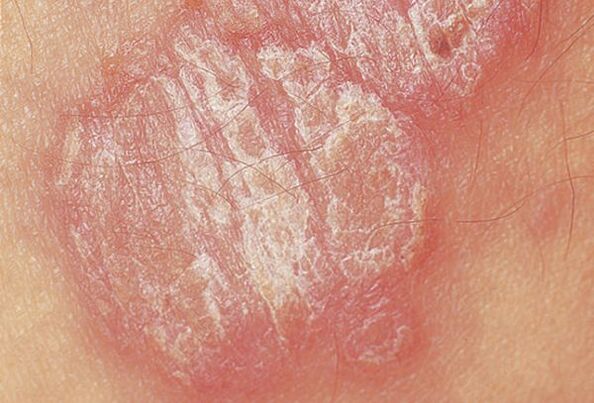
The first phenomenon of the triad is explained by the development of parakeratosis (improper epithelial function, which leads to a violation of the formation of the stratum corneum). To combat the deviation in the early stages, used local non -hormonal agents (creams, ointments).
Movie Terminal
It is characterized by the removal of a thin layer of tissue from the papule, which has a shiny structure and looks like polyethylene. It is easily separated by any impact (pressure, friction, etc. ) after removing the dry debris.

The terminal film is the last layer removed from the skin. Further scraping leads to the last stage of triad bleeding - drips.
At this stage, baths of medicinal herbs, drugs with anti-allergic effect, ointments naturally (without corticosteroids and hormones) are used.
Precise bleeding
Upon removal of the terminal film, droplet bleeding occurs in the affected skin area (favorable symptoms or "bloody dew") and accelerated neoplasm growth is observed, which sometimes reaches the size of a pea and is called lenticular. In some cases, papules grow to the diameter of small coins and distinguish as numular. With the progression of the disease, their growth increases and when combined, psoriatic plaques form.
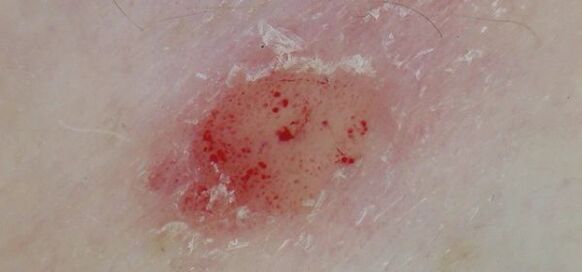
For treatment, retinoids, immunomodulators, anti-inflammatory drugs, physiotherapy are used.
Others
The disease can be identified by other characteristic signs, the main ones are 4:
- The rim is red, not covered with scales, which form around the papule.
- On clean areas of skin, small rashes can be seen (usually appearing before the stage of progressive psoriasis).
- The symptoms that help distinguish psoriasis from seborrheic dermatitis are characteristic of the active stage of the pathology. It is accompanied by the appearance of papules with clear borders on the scalp; this is not the case with seborrheic dermatitis.
- A light, shiny skin rim appears around the formation. These symptoms are typical for the degree of regression of the disease and appear when the papules disappear.
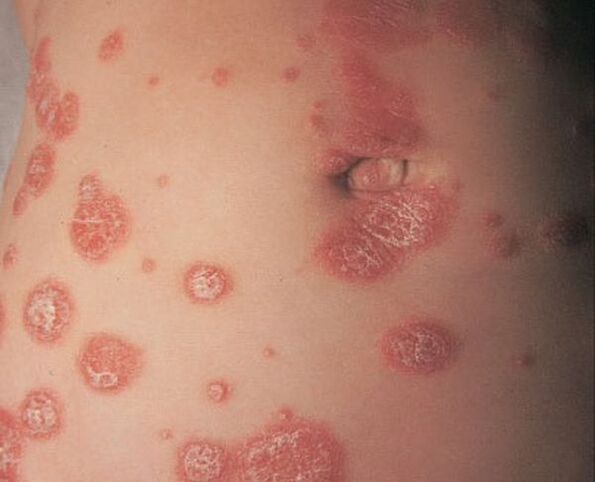
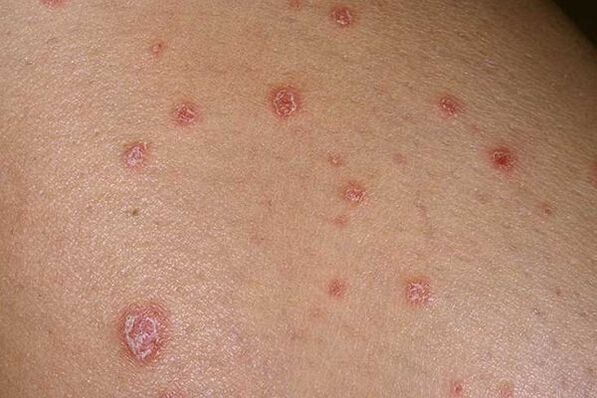
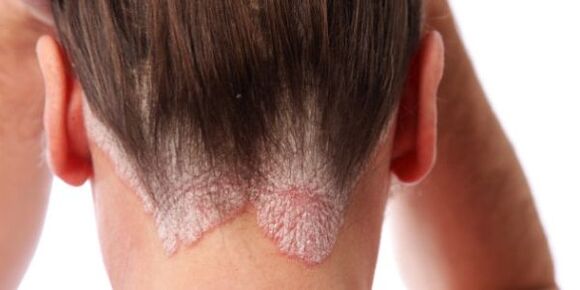

How it looks
In most cases, the onset of pathology is invisible: in the early stages, psoriasis affects small parts of the skin, especially at the bends of the limbs, head and along the hairline.
Attention!The initial manifestation occurs at the site of constant mechanical irritation of the skin, for example, where clothing rubs and presses.
Common symptoms:
- itching;
- excessive skin dryness;
- exfoliation of pathological elements;
- general health deterioration (weakness, lethargy, fever).
There are 3 stages of pathological papule development:
- Progressive.The appearance of a rash of bright pink color, surrounded by a rich and slightly blurred rim. In the center of the papule, the skin peels off, giving a white color formation. At this stage, a rash can appear at the site of scratches, cuts on the skin, bites, cuts, punctures, or burns.
- Still.It begins 1-4 weeks after the onset of the disease. New plaques do not appear, the old ones acquire a bright color, the intensity of exfoliation decreases.
- Regressive.The color of plaques and papules fades, their infiltration is reduced and their formation dissolves. The average duration of the decay period is from 2 to 6-8 months.

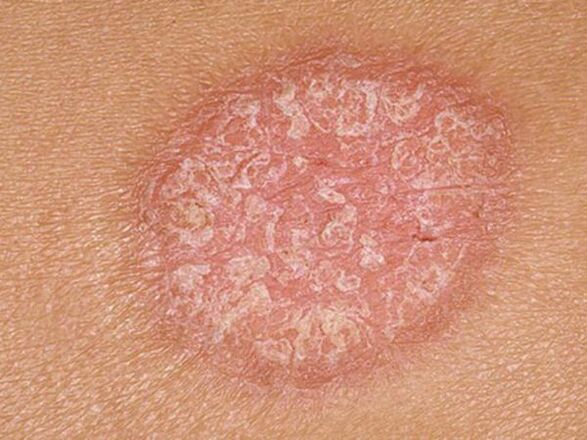

The symptoms of the disease depend on the type:
- Plaque(ordinary or obscene). The most common type of pathology. On various parts of the body (more often on the elbows, knees, head), appear oval or round plaques of red hue, covered with silvery white scales on it.
- Seborrheic.It occurs mainly on the scalp. It manifests itself as exfoliation and itching, spreading to the area behind the ears and skin along the hairline.
- Pustularits type is considered the most severe form, grows rapidly and affects large areas of skin. Painful rash appears on the body, which is accompanied by an increase in local temperature, weakness, headache, diarrhea. Vesicles filled with exudate immediately form on the lesion. In the future, the spots develop, merge with each other, forming large lesions on the body.
- Interrelated.Special for children, accompanied by the appearance of bright red papules, with a slight exfoliation (may not be there).
- Exudative.The affected part of the skin is not only flaky, but also wet, a yellowish crust is formed on the surface of the plaque.
- Psoriatic erythroderma.Red plaques with silvery, yellow or white scales are observed all over the body. It is accompanied by an increase in lymph nodes, an increase in body temperature. In the future, the formations merge into large spots that cause irritation and itching.
- Psoriatic arthritis.It is accompanied by "articular syndrome", in which the skin in the joint area (on the wrist, finger phalanges, spine, etc. ) is affected, and if measures are not taken in a timely manner, the disease affects the joints.
- Tearsaccompanied by numerous rashes, consisting of many small plaques. In this case, the papule is droplet -shaped, the color from bright red to purple.
- The point.It is characterized by the formation of small spots in various areas of the body, resembling spots, and there may be no exfoliation of the dermis.
- Rupioid.One type of chronic psoriasis. The crust appears in the formation, it becomes higher, taking the shape of a cone.
- Oldmanifests itself in large papules that do not pass for a long time, sometimes papillomas and warts form on it.
- Onychia psoriaticleading to deformation of the nail, the appearance of yellow-brown spots beneath it.
- Palmar-plantar.Appears on the palms and soles of the feet. The main symptoms are thickening of the skin, dryness, cracking.
- Psoriasis of the mucous membranesaffects the oral cavity and provokes the appearance of plaque on the mucous membranes.

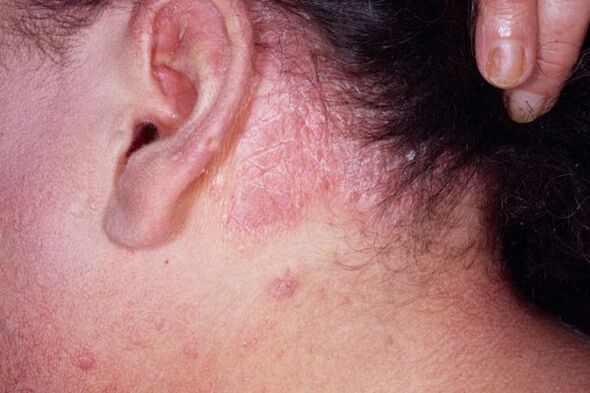

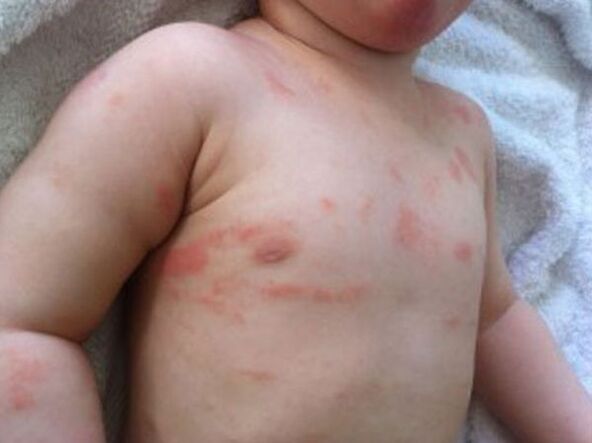
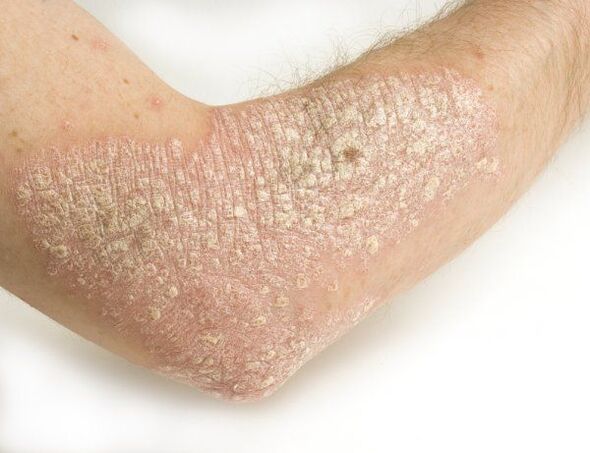
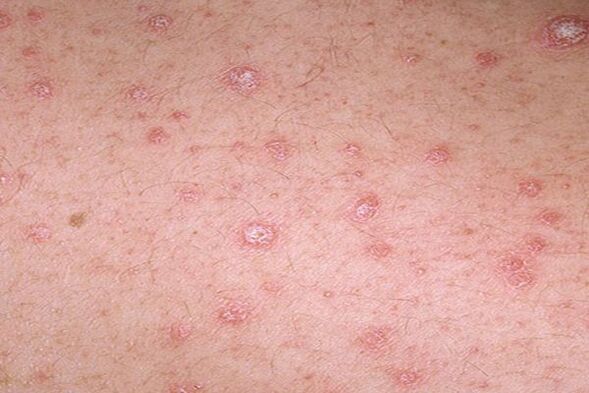
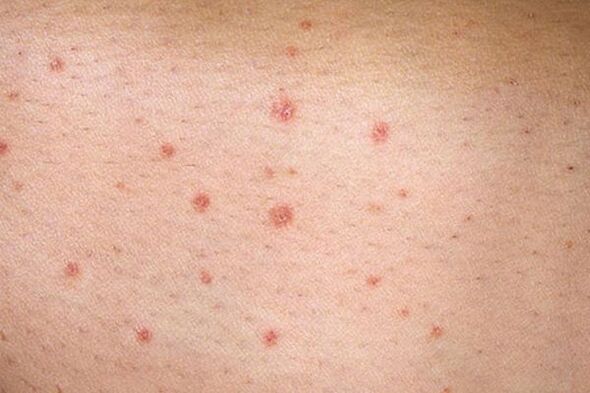

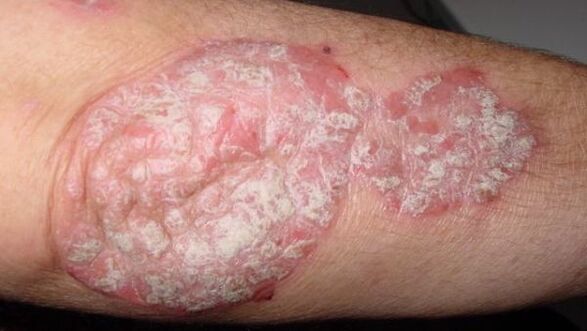

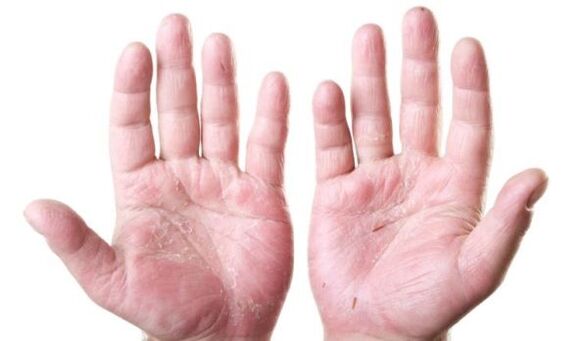

Localization of psoriasis
Hands
In most cases, the rash appears on the surface of the elbow or between the toes. Less commonly, papules are noted on the forearms.
Attention!Hands are characterized by pathological forms of plaque, but others are also found. The marks are small spots of red color, quickly covered with white scales, rough affected skin.
Feet
Psoriatic formation mainly occurs on the foot in the knee area, but it is likely that it formed in other parts of the foot.
The first rash is single and small with a clear outline, but loose, inflamed and very brittle. Precise papules spread rapidly to form conglomerates.
Chief
Often develops against the background of seborrhea, affects the hairline, forming a so -called psoriatic crown. The skin formation gradually grows and spreads all over the surface, resembling dandruff. This localization occurs quite frequently, more rarely a rash appears on the ear or behind it.
Toenails
Nail plates can be affected by the type:
- Bidal- forms of psoriasis. A small hole appears in the nail, which resembles a needle puncture mark.
- Onychomycosis- nails change color, dull, thicken and begin to peel. Through the plate, psoriatic papules surrounded by a reddish rim can be seen, similar to oil spots.
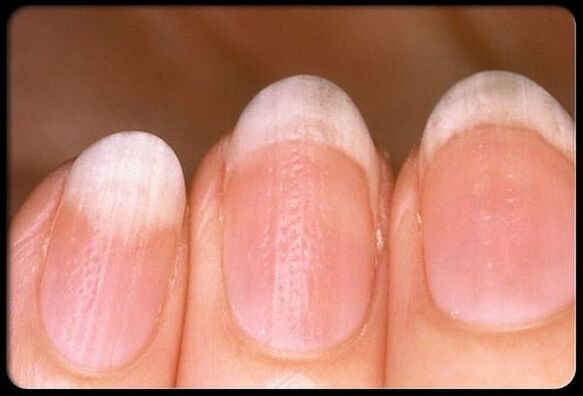
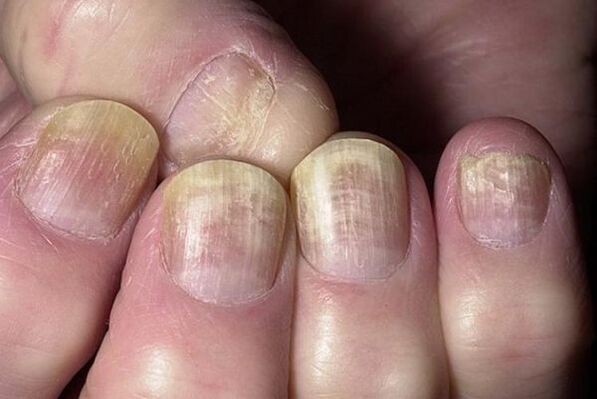
Badan
Usually manifests itself as characteristic papules that merge with each other. Psoriasis is more common in the back, more rarely in the neck, abdomen, hips, formations can be in the form of drops, points and plaques.
Face
It is rarely affected, the rash is located in the nasolabial folds, in the area of the temples and eyebrows, around the eyes. Rarely, the pathology affects the borders of the lips, the rash resembles herpes.
Palms and feet
Both zones are affected simultaneously, but there are cases when the pathology develops only on the feet or palms. In the soles of the feet, the disease is often combined with fungal pathology, which greatly complicates diagnosis and therapy.
This type of psoriasis is divided into 3 types:
- Papular plaque- the formation is dense, not prominent on the skin, difficult to separate the scales from the plaque. The rash occurs in the peripheral area, accompanied by edema and keratosis.
- Psoriatic callus- round dense papules, composed of keratin epidermis. The skin layer gradually thickens and rougher. As a result, easily injured, cracks appear. Almost no redness, the size of the growth is from 2-3 millimeters to 2-3 centimeters.
- Vesicular-pustular- manifests itself in the form of serous-purulent papules. Bubbles reach a diameter of 2 millimeters and tend to merge.
Sendi
Pathology can affect a person’s joints, leading to changes in the structure of their tissues, which, with progression, cause pain and deformation. External symptoms: a reddish rash appears on the skin. Internal symptoms - sore joints, especially during sleep, stiffness of movement, swelling is felt.
Important!First, psoriasis affects the small joints of the feet and hands, then spreads to the knees and elbows, and at an advanced stage, the intervertebral joints already suffer.
Itchy or not
In most cases, psoriatic disease is accompanied by itching of varying degrees of intensity, sometimes not only the spots, but the whole body itching. In the early stages, itching is mild, gradually increasing.
The level of intensity also depends on the location of the pathology. For example, psoriasis on the head feels itchy, while the skin peels off and falls in large fragments, the size of which is larger than dandruff. At the stationary stage, the itching is reduced, often giving a burning sensation. During remission, all major symptoms are mild.
Itching is aggravated by:
- relapse;
- climate change;
- general intoxication;
- gastrointestinal tract diseases;
- inclusion of scabies, allergies;
- HIV infection.
Severe itchy skin after drinking coffee, alcoholic beverages, spicy and spicy foods, chocolate and other allergens.
How to differentiate
For eczema
- The nature of the rash.With eczema, blisters or blisters are filled with fluid that comes out periodically. Psoriasis is characterized by the appearance of dry scaly papules, when removed, blood appears.
- Itchy skin.From eczema, the body feels itchy compared to psoriatic pathology.
- Color.In psoriasis, the scales have a silvery color, and in eczema, the affected area becomes bright red or red.
- Sick area.Eczema affects the soft and sensitive areas of the skin, armpits, and groin. Psoriasis is characterized by a rash on rough, hard and thick layers of skin (knees, elbows, head, etc. ).
- The cause of the disease.Psoriasis is often caused by neurogenic factors, and eczema is caused by allergies and damage to body functions.
- Features for rashes on the hands.With psoriasis, holes in the nail plate, and eczema are similar to fungal infections.
For seborrheic dermatitis
The clinical manifestations of the disease are similar, but there are several features from which you can distinguish them:
- for psoriasis, unhealthy skin glow and bleeding cracks are characteristic, and this is not observed with seborrheic dermatitis;
- dermatitis, unlike psoriasis, is not accompanied by rough skin and severe dryness;
- with psoriasis, the scales are silvery, and the seborrhea is yellow or white;
- seborrheic scales are easily removed, but psoriatic is not;
- dermatitis is more often observed in places of accumulation of sebaceous glands, and scaly disease - all over the body;
- scalp psoriasis appears to protrude beyond the hair growth area, and seborrheic pathology does not cross this line;
- the lesion area with squamous lichen is much larger than that of dermatitis.
From fungi
- Psoriasis appears in the presence of several provoking factors, such as heredity, mechanical damage to the skin, damage to the immune system, and so on. The second causative agent of the disease is simply the spores of the parasitic fungus.
- Psoriatic pathology is not contagious, is not spread by airborne droplets, or sexually, or through contact.
Attention!The fungus (onychomycosis) affects any contact, including in public places - saunas, swimming pools, gyms, and so on. It is spread from animals and humans.
- With psoriasis of the head, the structure of the hair does not change, while fungal diseases cause brittleness, dryness and hair loss.
- Unlike scaly lichen, onychomycosis of the feet and legs is accompanied by an unpleasant odor.
- With the defeat of scaly nails, the structure has changed in the early stages, and with the fungus for a long time, the structure and color of the nail plate does not change.
From pink moss
A hallmark of psoriasis is the "psoriatic triad". The disease develops gradually and goes through 3 stages. Pityriasis rosea (pityriasis) grows rapidly and continues to grow. Moreover, pityriasis is an infectious disease, but scaly lichen is not.
From neurodermatitis
- Atopic dermatitis (neurodermatitis) originates from allergies and is triggered by certain substances, for example, plant pollen, food, animal hair, and so on. The causes of psoriasis are different (hereditary, decreased immunity, psychosomatic, mechanical damage to the skin, etc. ).
- With neurodermatitis, the skin dries and becomes rough, and with psoriasis it becomes scaly and bleeding.
- Plaques with dermatitis consist of small separate elements, in the case of herpes zoster, papules are uniform and covered with silvery scales.
- The color of the rash with psoriasis is much brighter than with neurodermatitis.
For gout
The difference between gouty and psoriatic arthritis lies in the cause of its development. Gout occurs when uric acid crystals are stored in the cartilage of the joints. Deviations from the norm can be provoked by: arterial hypertension, obesity, taking diuretics, drinking alcohol, and so on.
Symptoms of psoriasis and gout are similar - severe pain at night, stiffness in movement, redness and swelling in the affected area. However, with psoriasis, in most cases, a special red rash appears first, and then pain.
Typical symptoms of gouty arthritis include:
- the presence of white nodules in the affected joint area;
- signs of kidney stones (back pain, blood in urine, etc. ).























